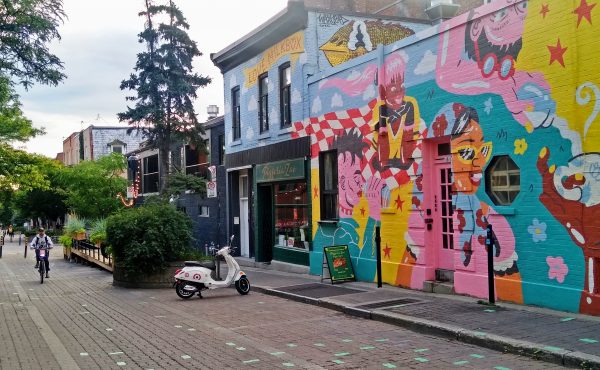Both Toronto and Montreal have made progress towards creating a connected network of bike lanes, yet each has taken a different approach. In the 1980s, Montreal became one of the earliest cities in Canada to install segregated on-street cycling infrastructure, whereas Toronto started to install the majority of its on-street painted bike lanes in early 1990s, only to receive its first segregated lane on Sherbourne in late 2012.
The purpose of this video — produced by Toronto Centre for Active Transportation (TCAT) — is to explore reasons for the segregated versus painted approach and provide a discussion about what each city could do to make their cycling network more connected, more convenient, and safer for all cyclists.
This conversation is timely. Outside of Toronto and Montreal, Canadian cities are entering into a new era of planning where urban cycling is becoming more mainstream. Planners, engineers, public health officials, and other stakeholders in cities of different shapes, sizes, and geographic contexts are beginning to collectively value cycling as a legitimate, practical, and necessary component of a healthy transportation system that contributes to a clean environment and vibrant economy.
We see the growth in the uptake of cycling infrastructure in communities of all shapes and sizes from across the country. From Vancouver’s growing network of segregated bike lanes, to Thunder Bay’s recent addition of painted on-street bike lanes, to the general growth of the Complete Streets for Canada movement in cities as diverse as Edmonton, Waterloo, Ajax, Calgary and Halifax.
While we have a long way to go before we become an urban cycling friendly nation, the wheels are well in motion.
Please see TCAT’s previous reports Benchmarking Active Transportation in Canadian Cities and Building Better Cycling Arteries in Cities for more information on cycling infrastructure in Canadian cities.
The video is also available on YouTube in French and Spanish.
CREDITS: Clean Air Partnership, Montreal Urban Ecology Centre, Eco Counter, editor Paul Neudorf, videographer Clark Ferguson, translator Sergio Echeverri, and Montreal-based Montag for the music.
photo by Paul Krueger



3 comments
Toronto’s current approach of improving recreational biking trails does not address the issue of my getting from where I am to where I want to be. My preference would be for a relatively safe route without diversions.
I am also not enthusiastic about mixed use bike trails. Along Queens Quay I would much rather be out dealing with cars than on the bike path with pedestrians. Cars are for the most part more predictable.
The proposals for bike paths on residential streets as a solution to cycling off arterial roads is futile. If I wish to travel from my home in Cabbagetown to my doctor at Christie pits, then I am going to go along Wellesley, Hoskins and Harbord, which, by the way, is a very busy cycling route.
When I was working at Bay & Bloor, my route to work was Wellesley west to Bay and then north and going home east on Bloor to Parliament and then south. There is no non-arterial route which would have gotten me to work and back.
Unfortunately, Toronto (and its mayor) still considers biking to be recreational and not a form of transportation.
Hi I have over the past 7 years commited to making the bike my main source of transportation.I am impress with some of the progress with the infastructure that has been devoloped and how the bike racks on the public transit has made it easy to commit to the bike.We still have a lot of work I spend a lot of time on google maps to create my own stress free routes as I travel from south Etobicoke to Lamgstaff and jane.